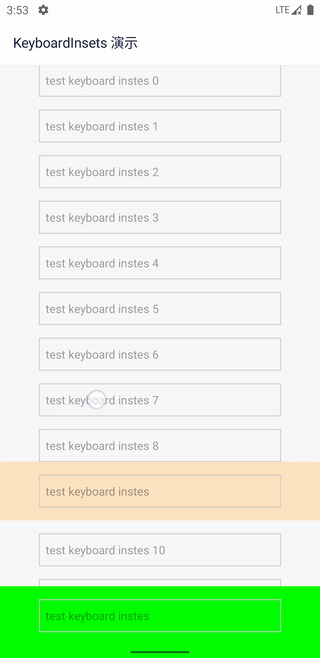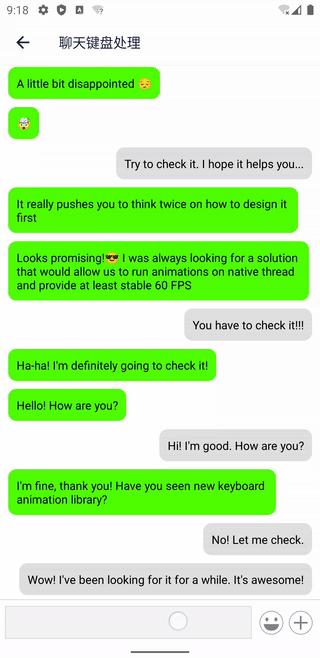react-native-keyboard-insets
v1.3.5
Published
A powerful Keyboard Aware View for React Native
Downloads
71
Readme
react-native-keyboard-insets
A powerful Keyboard Aware View for React Native.
使用简单,自动模式下不需要额外代码来处理键盘。
| 自动模式 | 手动模式 |
| ---------------------------------------------------------------------------------------------------------------- | ---------------------------------------------------------------------------------------------------------------- |
|  |
|  |
|
本库主要依据 Android 官方指南 Synchronize animation with the software keyboard 来实现,同时参考了 react-native-keyboard-controller。因为该库不是很符合我的需求,所以我自己写了一个。
Installation
yarn add react-native-keyboard-insetsiOS
cd ios
pod installAndroid
开启 edge-to-edge。 这将使得 APP 的 UI 撑满整个屏幕,而不是被系统 UI(譬如虚拟导航键)遮挡,从而实现更摩登的 UI 效果。
// MainActivity.java
import androidx.core.view.WindowCompat;
public class MainActivity extends ReactActivity {
@Override
protected void onCreate(Bundle savedInstanceState) {
super.onCreate(null);
// enable Edge-to-Edge
WindowCompat.setDecorFitsSystemWindows(getWindow(), false);
}
}为了更好的向后(Android 10 以前)兼容, 在 AndroidManifest 中设置 android:windowSoftInputMode="adjustResize"。
<!-- AndroidManifest.xml -->
<activity
android:name=".MainActivity"
...
android:windowSoftInputMode="adjustResize">
<intent-filter>
...
</intent-filter>
</activity>开启 Edge-to-Edge 后,你的 UI 会撑满整个屏幕,可使用 react-native-safe-area-context 来处理和系统 UI (譬如虚拟导航键) 重叠的部分。
可参考以下代码进行全局处理,也可以每个页面单独处理,以实现更美观更摩登的 UI 效果。
import { Platform } from 'react-native'
import { SafeAreaProvider, SafeAreaView } from 'react-native-safe-area-context'
function App() {
return (
<SafeAreaProvider>
<NavigationContainer>...</NavigationContainer>
{Platform.OS === 'android' && <SafeAreaView mode="margin" edges={['bottom']} />}
</SafeAreaProvider>
)
}如果使用 hybrid-navigation 作为导航组件,则不需要做任何事情,因为它已经帮你处理好了。
Usage
使用 KeyboardInsetsView 代替 View 作为容器,或者使用 KeyboardInsetsView 将 ScrollView 包裹起来。当键盘显示或隐藏时,KeyboardInsetsView 会自动调整自身的位置,以保证输入框不被键盘遮挡。
import { KeyboardInsetsView } from 'react-native-keyboard-insets'
function MyComponent() {
return (
<KeyboardInsetsView extraHeight={16} style={{ flex: 1 }}>
<ScrollView>
...
<TextInput />
...
</ScrollView>
</KeyboardInsetsView>
)
}Support Nested.
import { KeyboardInsetsView } from 'react-native-keyboard-insets'
function MyComponent() {
return (
<KeyboardInsetsView extraHeight={16} style={{ flex: 1 }}>
...
<KeyboardInsetsView extraHeight={8}>
<TextInput />
</KeyboardInsetsView>
...
</KeyboardInsetsView>
)
}KeyboardInsetsView 本质上是个 View,所以你可以使用 View 的所有属性,也可以和 View 互相替换。
KeyboardInsetsView 有两个额外的属性:
extraHeight:自动模式下,键盘总是紧贴着输入框的下边缘,这个属性设置输入框距离键盘的额外高度。KeyboardInsetsView 的最大偏移受键盘高度限制,若加入额外高度后,KeyboardInsetsView 偏移距离大于键盘高度,将产生截断,此时 KeyboardInsetsView 偏移距离等于键盘高度,底部将与键盘顶部相贴onKeyboard:是个回调函数,一旦设置,就进入手动模式,KeyboardInsetsView不会帮你调整输入框的位置。你需要利用这个回调函数实现自己想要的效果。onKeyboard的参数声明如下:interface KeyboardState { height: number // 键盘的高度,不会因为键盘隐藏而变为 0 shown: boolean // 当键盘将隐已隐时,这个值为 false;当键盘将显已显时,这个值为 true transitioning: boolean // 键盘是否正在显示或隐藏 position: Animated.Value // 键盘的位置,从 0 到 height,可以用来实现动画效果 }
API
useKeyboard为了方便用户编写
onKeyboard回调,keyboard-insets 提供了一个useKeyboardhook,使用方法如下:import { useKeyboard } from 'react-native-keyboard-insets' function MyComponent() { const { keyboard, onKeyboard } = useKeyboard() console.log(keyboard.height), // 键盘的高度 return ( <KeyboardInsetsView onKeyboard={onKeyboard}> <TextInput /> </KeyboardInsetsView> ) }getEdgeInsetsForView有时候你需要知道某个
View距离屏幕四边的距离,这个时候就可以使用getEdgeInsetsForView方法。import { getEdgeInsetsForView } from 'react-native-keyboard-insets' function MyComponent() { const inputRef = useRef<TextInput>(null) const onLayout = useCallback(() => { const viewTag = findNodeHandle(inputRef.current) if (viewTag === null) { return } // 获得 TextInput 距离屏幕四边的距离 getEdgeInsetsForView(viewTag, insets => { console.log('insets', insets) }) }, []) return ( <View> <TextInput ref={inputRef} onLayout={onLayout} /> </View> ) }
运行 example 项目
首先 clone 本项目
git clone [email protected]:listenzz/react-native-keyboard-insets.git
cd react-native-keyboard-insets然后在项目根目录下运行如下命令:
yarn install
# &
yarn start在 Android 上运行
首先,确保你有一个模拟器或设备
如果熟悉原生开发,使用 Android Studio 打开 example/android,像运行原生应用那样运行它,也可以使用命令行:
# 在项目根目录下运行
yarn android你可能需要运行如下命令,才可以使用 Hot Reload 功能
adb reverse tcp:8081 tcp:8081在 iOS 上运行
首先安装 cocoapods 依赖,在项目根目录下运行如下命令:
cd example/ios && pod install
# 成功安装依赖后,回到根目录
cd -如果熟悉原生开发,使用 Xcode 打开 example/ios,像运行原生应用那样运行它,或者使用命令行:
# 在项目根目录下运行
yarn ios